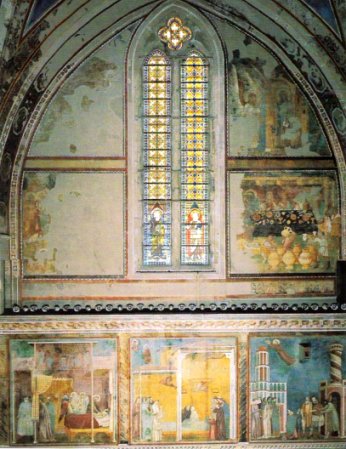|
Upper Church: Bay 4 |
|
S |
| North wall |
|
|
|
|
| Old Testament images. Top register:
The
creation of the World, The creation of Adam. Middle register: Noah
building the ark, the flood. (mostly lost.) Franciscan images: 1. Francis is honoured by a simple man. 2. Francis gives his cloak to a poor man. 3. The vision of the palace filled with arms in Spoleto. The Old Testament images show beginnings: the Creation, and the 'fresh start' following the flood. The first Franciscan image is taken from Bonaventure 1.1: 'A certain citizen of Assisi was regarded as a simpleton, yet he was one taught of God. When he met Francis going through the city, he would take off his cloak and spread the garment before his feet, declaring that Francis was worthy of great honour'. This can be seen as another 'fresh start' to redeeming sinful world. There is also a clear reference to the entry of Christ into Jerusalem. The building in the fresco is taken from life. It is the Temple of Minerva, once a pagan place of worship, then a church, which it still is; another fresh start. Francis giving his cloak to a poor man is a clear link with St Martin. The vision of the palace, based on Bonaventura 1.3, requires a little more explanation. Francis dreamed of a palace full of weapons, and, as a young soldier, rushed off there to offer his services. He heard the voice Christ on his journey telling him to renounce military glory. |
| South wall |
|
|
|
|
| New Testament scenes. Top register:
the
Visitation, the Annunciation. Middle register: The raising of
Lazarus The wedding at Cana. Franciscan scenes, 26. The immediate healing of John of Lerida in Catalonia. 27. The confession of the woman brought back to life. 28. St. Francis frees Peter of Alife. The New Testament scenes echo the Scenes on the
north wall - beginnings. There is another theme here too, that of
miracles, with clear parallels between the Gospel stories and the
legends of St Francis. |
|
|




